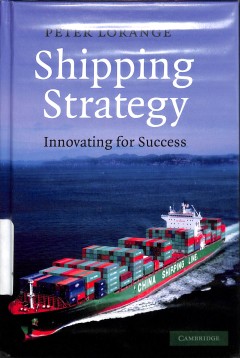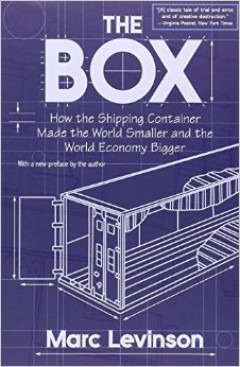Ditapis dengan

Course Outline & Study Guide : Shipping, Trade & Trasnportation Law
- Edisi
- Shipping, Trade & Trasnportation Law
- ISBN/ISSN
- -
- Deskripsi Fisik
- 11 page
- Judul Seri
- Shipping, Trade & Trasnportation Law
- No. Panggil
- CC STC COS s C1
- Edisi
- Shipping, Trade & Trasnportation Law
- ISBN/ISSN
- -
- Deskripsi Fisik
- 11 page
- Judul Seri
- Shipping, Trade & Trasnportation Law
- No. Panggil
- CC STC COS s C1

Reader Maritime Conversations : Shipping, Trade & Trasnportation Law
- Edisi
- Shipping, Trade & Trasnportation Law
- ISBN/ISSN
- -
- Deskripsi Fisik
- illus,; 30 cm
- Judul Seri
- Shipping, Trade & Trasnportation Law
- No. Panggil
- CC STC REA s C1
- Edisi
- Shipping, Trade & Trasnportation Law
- ISBN/ISSN
- -
- Deskripsi Fisik
- illus,; 30 cm
- Judul Seri
- Shipping, Trade & Trasnportation Law
- No. Panggil
- CC STC REA s C1
Maritime Economics
Selama 5000 tahun pengiriman telah melayani perekonomian dunia dan hari ini menyediakan layanan transportasi canggih untuk setiap bagian dari dunia. Namun meskipun kompleksitas ekonomi, pengiriman mempertahankan banyak dari pemotongan yang kompetitif dan tekanan dari "sempurna" pasar ekonomi klasik. Campuran logistik canggih dan lebih besar dari pengusaha kehidupan membuatnya menjadi studi k…
- Edisi
- Second Edition
- ISBN/ISSN
- 978-0-415-27558-3
- Deskripsi Fisik
- xxiv, 815p. ; 25cm.
- Judul Seri
- -
- No. Panggil
- TXT MR STO m

Shipping strategy : innovation for success
The shipping industry has an impact on each and every one of us every day. Ships transport the food we eat, the clothes we wear, the cars we drive, the materials used to build our homes, and the fuel that heats them. Yet traditional shipping companies - ones that combine various aspects of shipping under one organizational roof - are on the decline. They are gradually being replaced by new, mor…
- Edisi
- -
- ISBN/ISSN
- 978-0-521-76149-9
- Deskripsi Fisik
- xviii, 273 p., ; 24 cm ; index
- Judul Seri
- -
- No. Panggil
- LC 623.82 LOR s
safety and shipping review 2013
In 2012, two high profile maritime incidents pushed shipping safety into the public eye once more with the loss of the Costa Concordia off Italy in January followed in February by that of the Rabaul Queen ferry, off Papua New Guinea. Both events caused a tragic loss of life. However, while these incidents have dominated public ship safety discussions, statistics reveal that reported total losse…
- Edisi
- -
- ISBN/ISSN
- -
- Deskripsi Fisik
- 13 pages
- Judul Seri
- An annual review of trends and developments in shipping losses and safety – January 2013
- No. Panggil
- TXT LO ALI s

North American inland port development: international vs domestic shipper pre…
Changes in US transportation policy and changing freight flows influenced by NAFTA have refocused the attention of interior states on their transportation infrastructure. Shippers in the landlocked Midwest of the USA have inquired into the feasibility of inland ports that better facilitate domestic and global commerce by providing shared facilities and services. As such, these inland ports repr…
- Edisi
- Vol. 34 Iss 7 pp. 579 - 597
- ISBN/ISSN
- 0960-0035
- Deskripsi Fisik
- 21 p .
- Judul Seri
- -
- No. Panggil
- ATC PO WAL i

The Box : how the shipping container made the world smaller and the world eco…
container shipping is not ancient history, but much relatively recent source material proved surprisingly difficult to locate. Many relevant corporate records have been destroyed. The early growth of containerization was nurtured by the Port of New York Authority (now the Port Authority of New York and New Jersey), but many of that agency's records were destroyed in the terrorist attacks on the…
- Edisi
- -
- ISBN/ISSN
- 978-0-691-123 24-0
- Deskripsi Fisik
- ix, 365p
- Judul Seri
- -
- No. Panggil
- TXT LO LEV t
(Lloyd's practical shipping guides) Mark Rowbotham - introduction to marine c…
Two-thirds of the surface of the globe is occupied by water, either fresh or salt. Fresh water only accounts for a small percentage of this total, as the vast majority is accounted for by salt water in the form of the world’s seas and oceans. These masses of water separate continents from each other, as well as providing a source of livelihood to a wide variety of people and professions, from…
- Edisi
- 2nd ed
- ISBN/ISSN
- 978-1-31581-401-8
- Deskripsi Fisik
- xxi, 403p
- Judul Seri
- -
- No. Panggil
- TXT LO ROW l
Shipping and ports in the twenty-first century globalisation, technological c…
This book originated in two meetings – Oceans at the Millennium (2000) and Oceans of Change (2002) – both held at the National Maritime Museum, Greenwich, UK, and organised jointly by the Museum and the International Geographical Union’s Commission on Marine Geography. The object of both meetings was to create forums for discussion of the problems associated with the use and protection of…
- Edisi
- -
- ISBN/ISSN
- 0-203-57119-3
- Deskripsi Fisik
- XXI, 274p
- Judul Seri
- -
- No. Panggil
- TXT LO PIN s

Multi-Attribute decision making for crew nationality pattern selection in the…
This paper investigates selection of crew nationality pattern strategy. Manning task is one of the most reported problems in shipping business. Increasing life quality of countries influences popularity of on board employments and its cost has crucial share in total terms. Although many shipping firms have preferred domestic crew, because of excess crew costs and some other reasons, multination…
- Edisi
- Volume 26
- ISBN/ISSN
- -
- Deskripsi Fisik
- 14 p .
- Judul Seri
- -
- No. Panggil
- ATC PO BUL m

Shipping market integration the case of sticky newbuilding prices
In this article we derive an equation defining contemporaneous equilibrium prices across the four shipping markets: the newbuilding market, the second-hand market, the demolition market and the freight market. The model requires rather general conditions, namely that (i) all second-hand ships are priced based on linear depreciation down to scrap value, (ii) expectations of the future scrap valu…
- Edisi
- Vol. 17, 4, 389–398
- ISBN/ISSN
- -
- Deskripsi Fisik
- 10 p.
- Judul Seri
- -
- No. Panggil
- ATC PO ADL s
The Shipping Industry, Ocean Governance and Environmental Law in the Paradigm…
In contemporary Arctic, there are numerous specific issues, i.e. theories on how to delineate jurisdictional boundaries, regulatory codes to deal with ameliorated commercial shipping, regulations on how to prepare for the possibility of oil spills under Arctic conditions, rules to impose on tour operators and so forth. In short, it is apparent that there is no scarcity of legal framework for th…
- Edisi
- -
- ISBN/ISSN
- 978-3-319-12540-4
- Deskripsi Fisik
- vii, 113p
- Judul Seri
- -
- No. Panggil
- TXT LO JOH t

Ocean shipping deregulation restructures the liner shipping industry
Significant pro-competitive changes were made to the Shipping Act by the Ocean Shipping Reform Act (OSRA). The most notable of these was the shift away from public tariffs and publicly available contract rates to confidential rates using individually negotiated service contracts. The number of individual member service contracts has risen dramatically since OSRA went into effect in 1999. These …
- Edisi
- Vol. 41
- ISBN/ISSN
- 0308-8839
- Deskripsi Fisik
- 16 pages
- Judul Seri
- -
- No. Panggil
- ATC PO DON o

Proposing a common platform of shipping cost analysis of the Northern Sea Rou…
Maritime trade between East Asia and Northwest Europe using the Northern Sea Route (NSR) has been recently increasing, because ship operators may take advantage of the shorter sailing distance of NSR whose navigable season has become longer because of retreating Arctic sea ice. As Arctic sea ice continues to retreat because of global warming, the NSR is now approximately 40 per cent shorter tha…
- Edisi
- Vol. 17, 1, 9–31
- ISBN/ISSN
- -
- Deskripsi Fisik
- 23 pages
- Judul Seri
- -
- No. Panggil
- ATC PO FUR p

Safety and shipping review 2015
Safety of international shipping vessels is critical to the global economy. More than 90% of trade is estimated to be transported by sea. The maritime industry continued to improve its safety record in 2014 with 75 total losses reported worldwide; the lowest in 10 years. Losses declined by 32% compared with 2013 (110). The 2014 accident year also represents a significant improvement on the 10-y…
- Edisi
- -
- ISBN/ISSN
- -
- Deskripsi Fisik
- 36 pages
- Judul Seri
- -
- No. Panggil
- TXT LO ALI s
 Karya Umum
Karya Umum  Filsafat
Filsafat  Agama
Agama  Ilmu-ilmu Sosial
Ilmu-ilmu Sosial  Bahasa
Bahasa  Ilmu-ilmu Murni
Ilmu-ilmu Murni  Ilmu-ilmu Terapan
Ilmu-ilmu Terapan  Kesenian, Hiburan, dan Olahraga
Kesenian, Hiburan, dan Olahraga  Kesusastraan
Kesusastraan  Geografi dan Sejarah
Geografi dan Sejarah